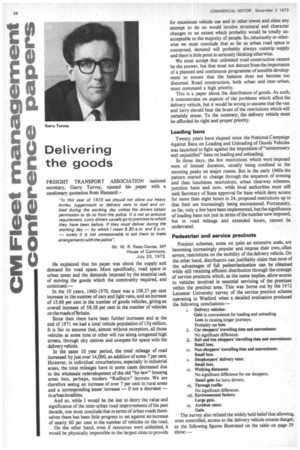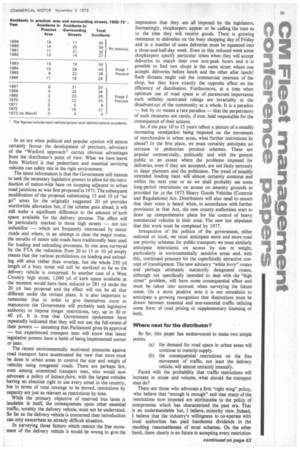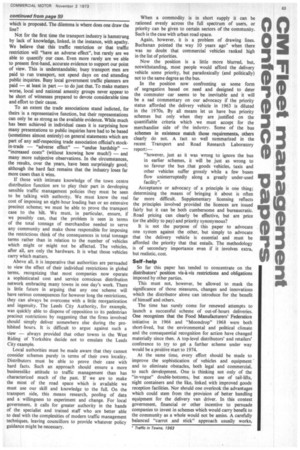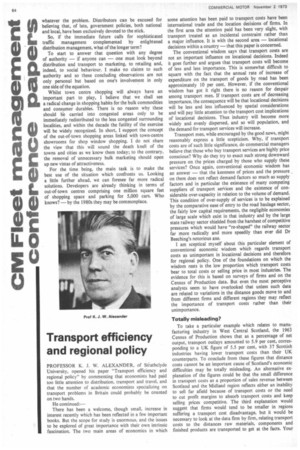Delivering the goods
Page 60

Page 61

Page 65

Page 66

If you've noticed an error in this article please click here to report it so we can fix it.
FREIGHT TRANSPORT ASSOCIATION national secretary, Garry Turrey, opened his .paper with a cautionary quotation from Hansard: –
"In this year of 1973 we should not allow our heavy lorries, juggernauts or delivery vans to load and unload during the working day unless the drivers obtain permission to do so from the police. It is not an arduous requirement. Lorry drivers usually go to premises to which they have been before, If they must deliver during the working day — by which I mean 8.30 a.m. and 5 p.m. — surely it is not unreasonable to ask them to make arrangements with the police".
Mr. W. R. Rees-Davies, MP House of Commons.
July 20, 1973.
He explained that his paper was about the supply and demand for road space. More specifically, road space in urban areas and the demands imposed by the essential task of moving the goods which the community required, and continued:—
In the 10 years, 1960-1970, there was a 108.37 per cent increase in the number of cars and light vans, and an increase of 15.68 per cent in the number of goods vehicles, giving an overall increase of 58.38 per cent in the number of vehicles on the roads of Britain.
Since then there have been further increases and at the end of 1971 we had a total vehicle population of 154 million. It is fair to assume that, almost without exception, all those vehicles at some time or other will run along congested high streets, through city centres and compete for space with the delivery vehicle.
In the same 10 year period, the total mileage of road increased by just over 14,000, an addition of some 7 per cent. However, in individual conurbations, especially in industrial areas, the total mileages have in some cases decreased due to the wholesale redevelopment of the old "by-law" housing areas into, perhaps, modern "Radburn" layouts. We are therefore seeing an increase of over 7 per cent in rural areas and a corresponding lesser increase — if not a decrease — in urban localities.
And so, while I would be the last to decry the value and significance of the inter-urban road improvements of the past decade, one must conclude that in terms of urban roads themselves there has been little progress to set against an increase of nearly 60 per cent in the number of vehicles on the road.
On the other hand, even if resources were unlimited, it would be physically impossible in the largest cities to provide for maximum vehicle use and in other towns and cities any attempt to do so would involve structural and character changes to an extent which probably would be totally unacceptable to the majority of people. So, reluctantly or otherwise we must conclude that so far as urban road space is concerned, demand will probably always outstrip supply and there is little point in seriously thinking otherwise.
We must accept that unlimited road construction cannot be the answer, but that must not detract from the importance of a planned and continuous programme of sensible development to ensure that the balance does not become too distorted. Road construction, both urban and inter-urban, must command a high priority.
This is a paper about the distribution of goods. As such, it concentrates on aspects of the problems which affect the delivery vehicle, but it would be wrong to assume that the van and lorry should bear the brunt of the restrictions which will certainly ensue. To the contrary, the delivery vehicle must be afforded its right and proper priority.
Loading bans Twenty years have elapsed since the National Campaign Against Bans on Loading and Unloading of Goods Vehicles was launched to fight against the imposition of "unnecessary and unjustified" bans on loading and unloading.
In those days, the few restrictions which were imposed were of limited duration, usually being confined to the morning peaks on major routes. But in the early 1960s the pattern started to change through the sequence of evening and then lunchtime restrictions, urban clearway schemes, junction bans and now, while local authorities must still seek Secretary of State approval for bans which deny access for more than eight hours in 24, proposed restrictions up to that limit are increasingly being encountered. Fortunately, so far, only a few have been implemented, but the significance of loading bans not just in terms of the number now imposed, but in road mileage and extended hours, cannot be underrated.
Pedestrian and service precincts Precinct schemes, some on quite an extensive scale, are becoming increasingly popular and impose their own, often severe, restrictions on the mobility of the delivery vehicle. On the other hand, distributors can justifiably claim that most of the advantages of full pedestrianization can be obtained while still retaining efficient distribution through the concept of service precincts which, as the name implies, allow access to vehicles involved in essential servicing of the premises within the precinct area. This was borne out by the 1972 Leicester University survey of the service precinct scheme operating in Watford when a detailed evaluation produced the following conclusions: The survey also refuted the widely held belief that allowing, even controlled, access to the delivery vehicle creates danger, as the following figures illustrated on the table on page 59 show:—
In an era when political and popular opinion will almost certainly favour the development of precincts, advocacy of the "Watford approachcarries obvious advantages from the distributor's point of view. What we have learnt from Watford is that pedestrians and essential servicing vehicles can safely mix in the right environment.
The latest information is that the Government still intends to seek the necessary legislative powers to allow for the introduction of nation-wide bans on stopping adjacent to urban road junctions as was first proposed in 1971. The subsequent modification of the proposal substituting 15 and 10 yd "no go" areas for the originally suggested 20 yd provides worthwhile alleviation but, if the scheme goes ahead, it will still make a significant difference to the amount of kerb space available for the delivery process. The effect will be particularly marked in those high streets — not too unfamiliar — which are frequently intersected by minor roads and where, in an attempt to clear the major routes, the mouths of minor side roads have traditionally been used for loading and unloading processes. In one area surveyed by the FTA the reduction from 20 to 15 or 10 yd simply means that the various prohibitions on loading and unloading will abut rather than overlap, but the whole 250 yd length of a busy street will still be sterilized so far as the delivery vehicle is concerned. In another case of a West Country high street, 1,090 yd of kerb space available at the moment would have been reduced to 281 yd under the 20 yd ban proposal and the effect will not be all that different under the revised plans. It is also important to remember that in order to give themselves room to manoeuvre the Government will probably seek legislative authority to impose longer restrictions, say, up to 30 or 40 yd. It is true that Government spokesmen have repeatedly indicated that they will not use the full extent of their powers — assuming that Parliament gives its approval — but experienced transport men will know that latent legislative powers have a habit of being implemented sooner or later.
The recent environmentally motivated pressures against road transport have accentuated the view that more must be done in urban areas to control the size and weight of vehicles using congested roads. There are perhaps few, even among committed transport men, who would now advocate a policy of laissez-faire, with the largest vehicles having an absolute right to use every street in the country, but in terms of total tonnage to be moved, restrictions by capacity are just as relevant as restrictions by time.
While the primary objective of reserved bus lanes is laudable in itself, the consequences upon other essential traffic, notably the delivery vehicle,•must not be underrated. So far as the delivery vehicle is concerned their introduction can only exacerbate an already difficult situation.
In surveying those factors which restrict the free movement of the delivery vehicle it would be wrong to give the impression that they are all imposed by the legislators. Increasingly, shopkeepers appear to be calling the tune as to the time they will receive goods. There is growing resistance to deliveries on the busy shopping day of Friday and in a number of cases deliveries must be squeezed into a three-and-half-day week. Even in this reduced week some shopkeepers specify particular times when they will accept deliveries to match their own non-peak hours and it is possible to find two shops in the same street where one accepts deliveries before lunch and the other after lunch! Such dictates might suit the commercial interests of the shop, but they have exactly the opposite effect on the efficiency of distribution. Furthermore, at a time when optimum use of road space is of paramount importance such selfishly motivated rulings are invariably to the disadvantage of the community as a whole. It is a paradox — but by no means a rare paradox — that the perpetrators of such measures are rarely, if ever, held responsible for the consequence of their actions.
So. if the past 10 to 15 years reflect a picture of a steadily increasing straitjacket being imposed on the movement of merchandise in urban areas, what further restrictions lie ahead? In the first place, we must certainly anticipate an increase in pedestrian precinct schemes. These are popular commercially, politically and with the general public to an extent where the problems imposed for deliveries, even if they are accepted, are not likely seriously to deter planners and the politicians. The trend of steadily extended loading bans will almost certainly continue and within the next year or so we shall probably see some long-period restrictions on access on amenity grounds as provided for in the 1973 Heavy Goods Vehicles (Controls and Regulations) Act. Distributors will also need to ensure that their voice is heard when, in accordance with further provisions in that Act, the new county authorities start to draw up comprehensive plans for the control of heavy commercial vehicles in their area. The new law stipulates that this work must be completed by 1977.
Irrespective of the politics of the government, either national or local, we must anticipate more and more road use priority schemes for public transport; we must similarly anticipate restrictions on access by size or weight, particularly in environmentally sensitive areas and, with this, continued pressure for the superficially attractive concept of transhipment. The new advisory -white lorry" routes and perhaps ultimately statutorily designated routes, although not specifically intended to deal with the "high street" problem, will have some consequential effect and must be taken into account when surveying the future scene. On a more positive note it is not unrealistic to anticipate a growing recognition that distinctions must be drawn between essential and non-essential traffic utilizing some form of road pricing or supplementary licensing or both.
Where next for the distributor?
So far, this paper has endeavoured to make two simple points.
(a) the demand for road space in urban areas will continue to outstrip supply.
(b) the consequential restrictions on the free movement of traffic, not least the delivery vehicle, will almost certainly intensify.
Faced with the probability that traffic restrictions will increase in scope and volume, what should the transport man do?
There are those who advocate a firm "right wing" policy, who believe that -enough is enough" and that many of the
restrictions now imposed are attributable to the policy of compromise which has characterized the past era. That is an understandable but, I believe, minority view. Indeed, I believe that the industry's willingness to co-operate with local authorities has paid handsome dividends in the resulting reasonableness of most schemes. On the other hand, there clearly is no future in accepting every restriction
which is proposed. The dilemma is where does one draw the line?
Not for the first time the transport industry is hamstrung by lack of knowledge, linked, in the instance, with apathy. We believe that this traffic restriction or that traffic restriction will have an adverse effect", but rarely are we able to quantify our case. Even more rarely are we able to present first-hand, accurate evidence to support our point of view. This is understandable; busy transport men are paid to run transport, not spend days on end attending public inquiries. Busy local government traffic planners are paid — at least in part — to do just that. To make matters worse, local and national amenity groups never appear to be short of witnesses prepared to devote considerable time and effort to their cause.
To an extent the trade associations stand indicted, for theirs is a representative function, but their representations can only be as strong as the available evidence. While much has been achieved in individual cases it is surprising how many presentations to public inquiries have had to be based (sometimes almost entirely) on general statements which are part of any self-respecting trade association official's stock in-trade — "adverse effect" — "undue hardship" — "increased costs" (without knowing how much!) — and many more subjective observations, In the circumstances, the results, over the years, have been surprisingly good; although the hard fact remains that the industry loses far more cases than it wins.
If those with intimate knowledge of the town centre distribution function are to play their part in developing sensible traffic management policies they must be seen to be talking with authority. We must know the real cost of imposing an eight-hour loading ban or an extensive precinct scheme; we must be able to prove the transport case to the hilt. We must, in particular, ensure, if we possibly can, that the problem is seen in terms of the total tonnage of merchandise needed to serve any community and make those responsible for imposing the restrictions think of the consequences in total tonnage terms rather than in relation to the number of vehicles which might or might not be affected. The vehicles, after all, are only the hardware. It is what those vehicles carry which matters.
Above all, it is imperative that authorities are persuaded to view the effect of their individual restrictions in global terms, recognizing that most companies now operate a sophisticated cost and service conscious distribution network embracing many towns in one day's work. There is little future in arguing that any one scheme will have serious consequences for however long the restrictions. they can always be overcome with a little reorganization and ingenuity. The Leeds City Authority, for example, was quickly able to dispose of opposition to its pedestrian precinct restrictions by suggesting that the firms involved
should simply deliver somewhere else during the prohibited hours. It is difficult to argue against such a view — always provided that other towns in the West Riding of Yorkshire decide not to emulate the Leeds City example.
Local authorities must be made aware that they cannot consider schemes purely in terms of their own locality.
Distributors must be able to prove their case with hard facts. Such an approach should ensure a more businesslike attitude to traffic management than has characterized much of the past. If we are to make the most of the road space which is available we must use our skill and knowledge to the full. On the transport side, this means research, pooling of data and a willingness to experiment and change. For local government, it calls for greater authority in the hands of the specialist and trained staff who are better able to deal with the complexities of modern traffic management techniques. leaving councillors to provide whatever policy guidance might be necessary. When a commodity is in short supply it can be rationed evenly across the full spectrum of users, or priority can be given to certain sectors of the community. Such is the case with urban road space.
Again, however, it is a problem of drawing lines. Buchanan pointed the way 10 years ago' when there was no doubt that commercial vehicles ranked high in the list of priorities.
Now the position is a little more blurred, but, notwithstanding, most people would afford the delivery vehicle some priority, but paradoxically (and politically) not to the same degree as the bus.
In the position now confronting us some form of segregation based on need and designed to deter the commuter car seems to be inevitable and it will be a sad commentary on our advocacy if the priority status afforded the delivery vehicle in 1963 is diluted in the 1970s. By all means let us have bus priority schemes but only when they are justified on the quantifiable criteria which . we must accept for the merchandise side of the industry. Some of the bus schemes in existence match those requirements, others clearly do not. A tact so well summarized in the recent Transport and Road Research Laboratory report:— "however, just as it was wrong to ignore the bus in earlier schemes, it will be just as wrong to so favour the bus that goods vehicles, taxis and other vehicles suffer grossly while a few buses flow uninterruptedly along a greatly under-used facility".
Acceptance or advocacy of a principle is one thing; determining the means of bringing it about is often far more difficult. Supplementary licensing reflects the principles involved provided the licences are issued fairly but it can be both cumbersome and bureaucratic. Road pricing can clearly be effective, but are price (or the ability to pay) and priority synonymous?
It is not the purpose of this paper to advocate one system against the other, but simply to advocate that the delivery vehicle is essential and must be afforded the priority that that entails. The methodology is of secondary importance even if it involves extra, but realistic, cost.
Self-help So far this paper has tended to concentrate on the distributors' position vis-à-vis restrictions and obligations imposed by other parties.
This must not, however, be allowed to mask the significance of those measures, changes and innovations which the distributor alone can introduce for the benefit of himself and others.
The time has surely come for renewed attempts to launch a successful scheme of out-of-hours deliveries.
One recognizes that the Food Manufacturers' Federation initiative in 1966 and "Moondror 1968 were both short-lived, but the environmental and political climate and the consequential recognition for action have changed materially since then. A top-level distributors' and retailers' conference to try to get a further scheme under way would be a positive start to 1974.
At the same time, every effort should be made to improve the sophistication of vehicles and equipment and to eliminate obstacles, both legal and commercial.
to such development. One is thinking not only of the "in-voguedouble-bottoms, but more use of tail-lifts,
night containers and the like, linked with improved goods reception facilities. Nor should one overlook the advantages which could stem from the provision of better handling equipment for the delivery van driver. In this context government, financial or other incentive to persuade companies to invest in schemes which would carry benefit to
the community as a whole would not be amiss. A carefully balanced -carrot and stick" approach usually works,
whatever the problem. Distributors can be excused for believing that, of late, government policies, both national and local, have been exclusively devoted to the stick.
So, if the immediate future calls for sophisticated traffic management complemented by enlightened distribution management, what of the longer term?
To start to answer that question with any degree of authority — if anyone can — one must look beyond distribution and transport to marketing, to retailing and, indeed, to social behaviour. I make no claims to such authority and so these concluding observations are not only personal but based on one's involvement in only one side of the equation.
Whilst town centre shopping will always have an important part to play, I believe that we shall see a radical change in shopping habits for the bulk commodities and consumer durables. There is no reason why these should be carried into congested areas only to be immediately redistributed to the less congested surrounding localities, and within the decade the futility of the exercise will be widely recognized. In short, I support the concept of the out-of-town shopping areas linked with town-centre showrooms for shop window shopping. I do not share the view that this will sound the death knell of the towns and cities as we know them today; to the contrary, the removal of unnecessary bulk marketing should open up new vistas of attractiveness.
For the time being, the main task is to make the best use of the situation which confronts us. Looking a little further ahead, we can foresee far more radical solutions. Developers are already thinking in terms of out-of-town centres comprising one million square feet of shopping space and parking for 5,000 cars. Who knows? — by the 1980s they may be commonplace.
























































































































